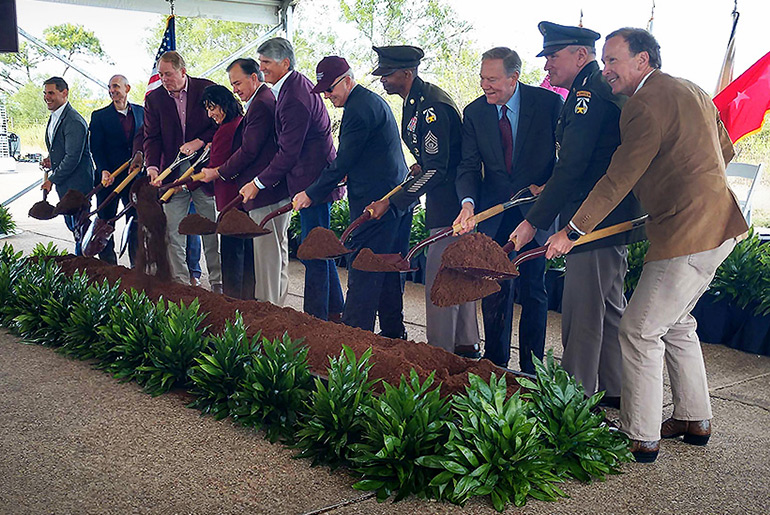
Texas A&M University System, U.S. Army and Army Futures Command (AFC) officials and the Bush family were on the RELLIS Campus today for the official groundbreaking and naming of the new Bush Combat Development Complex (BCDC), named in honor of former President George H.W. Bush.
“We face a complex security environment, one that requires we maintain our competitive edge today while simultaneously building tomorrow’s. I am grateful for the commitment from the people of Texas and especially The Texas A&M University System to help the Army ensure we never send our service members into a fair fight now and in the future,” said James McPherson, senior official performing the duties of the Under Secretary of the Army.
Neil Bush, son of the President and the late Barbara Bush, was in attendance and spoke on behalf of the Bush family about the name. “My father loved Texas A&M University and this community. He also loved his country and was both a proud veteran and commander in chief. Having a facility dedicated to providing this nation’s military men and women with the most technologically advanced equipment possible is a tremendous honor to my father’s memory and his service to this country,” said Bush.
The $130 million, Bush Combat Development Complex will allow the Texas A&M System to provide an ecosystem to accelerate research and technology development to modernize the Army.
This investment is comprised of $50 million from the Texas Legislature during the 2019 session for establishing an “Innovative Proving Ground” at RELLIS, and $80 million from the Texas A&M System Board of Regents for constructing a “Research Innovation Center” and affiliated infrastructure, also at RELLIS.
“When we first envisioned how we could use the RELLIS Campus to support the Army, one name came to mind, George Herbert Walker Bush, the 41st U.S. President. The Bush Combat Development Complex will provide a living laboratory unlike any other and will uphold the highest values of service to our nation,” said John Sharp, Chancellor of the Texas A&M System.
Last week, U.S. Senator John Cornyn, the AFC and the Texas A&M System announced a cooperative agreement that will provide up to $65 million over the next five years to the Texas A&M System to support research into new technologies to help the AFC advance national security. The goal is to shorten the time it takes to get emerging technologies from the lab to the field and maximize technology capabilities through soldier feedback.
A team of Army and Texas A&M System researchers will quickly evaluate prototypes that can be tested by soldiers in a real-world environment, using a vast array of sensors and instruments at RELLIS. Achieving the goals of the agreement will result in more capable and survivable hypersonic flight systems and materials, more lethal directed energy systems and more effective autonomous maneuvering vehicles.
“Texas continues to be at the epicenter of development in advanced technologies, and the new Bush Combat Development Complex at Texas A&M System’s RELLIS Campus is a perfect example to continue that momentum,” said State Rep. Greg Bonnen (R-League City). “The technology which will be created and tested here will not only help advance our military, but it will also keep our soldiers safer in the field.”
“The agreement between the Texas A&M System and U.S. Army Combat Capabilities Development Command Army Research Laboratory is the first step in a long-term partnership with the Army Futures Command,” said Sharp.
“The Combat Development Complex will bring together diverse partners from businesses - large and small - academia, and most importantly, our soldiers,” said Gen. John “Mike” Murray, commanding general for the Army Futures Command. “That’s an important lesson we’ve learned here at Army Futures Command: when we bring the team together, we can innovate faster to develop game-changing solutions. By testing emerging technology in an operationally relevant environment, with soldiers providing feedback, we can evaluate it early to ensure we’re getting exactly what our troops need in the field.”
The BCDC will be a full complement of facilities, equipment and instrumentation consisting of the Innovation Proving Ground (IPG); Research Integration Center (RIC); Ballistic, Aero-optics, and Materials (BAM); and the Technology Innovation and Modernization Catalyst (TIMC).
The IPG will provide a challenging outdoor test site for autonomous aerial, ground and subterranean vehicles. The technological systems involved are highly complex, involving networks and sensors and innovative operating systems.
The RIC will be a state-of-the-art innovation hub where researchers, students, industry, government and the military can collaborate to create emerging technologies that will modernize the Army. The use of high-tech maker spaces will lead to product development that is tested and evaluated by soldiers, allowing for continual and real-time design feedback.
The BAM will be a one-of-a-kind facility in which hypersonics and directed energy research will be conducted. BAM will feature an above-ground tunnel that is 1 kilometer long and 2 meters in diameter with integrated sensors. The BAM will also have laboratories, runways, underground and open-air battlefields, and a resilient network of sensors and systems for data collection, analysis and storage. In addition to BAM’s use by the AFC, it will be available to other military branches and defense contractors.
The TIMC will support the management and transfer of intellectual property and technology to industry for commercial applications. The facility will provide space for early stage technology ventures, business services, commercialization training and startup launch support services to inventors and innovators.
Army Futures Command has tasked Texas A&M System researchers to focus on several key areas. Specifically, the research will address hypersonic and laser systems; materials for withstanding hypervelocity blasts; coordinated maneuvering of air and ground vehicles; and resilient computer networks for autonomous vehicles to share up-to-the-moment battlefield information.
The target date for completion of the BCDC’s Innovative Proving Ground and Research Innovation Center is June 2021.
